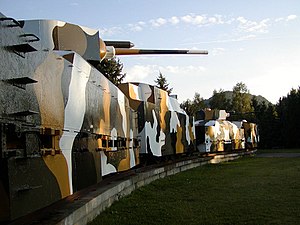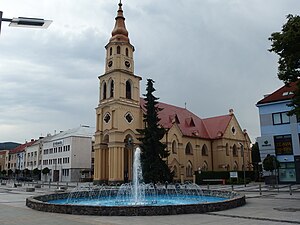Zvolen

Zvolen (pronounced [ˈzʋɔlɛn] ; Template:Lang-hu; Template:Lang-de) is a town in central Slovakia, situated on the confluence of Hron and Slatina rivers, close to Banská Bystrica. It is a seat of an okres (Zvolen District).
Etymology
The name is of Slovak (Slavic) origin meaning "the chosen one, splendid, excellent". The Hungarian Zólyom and the German Sohl were derived from the Latinized form Zolium[1] (earliest mention 1135). An adjective "Old" (Template:Lang-de, Template:Lang-sk, Template:Lang-la) distinguish Zvolen from Banská Bystrica (Template:Lang-de).[1]
History
Zvolen has been inhabited since the Paleolithic. In the 9th century, a Slavic settlement (today the Môťová neighborhood) became a regional center of what is now central Slovakia. Zvolen remained the capital of Zólyom County until the 1760s. In the 11th and 12th centuries, one of the largest medieval castles in Europe, Pustý hrad, was constructed. The town, originally built under the castle, lay on an important trade route (Via Magna) from Buda to Kraków. Zvolen was granted town privileges by King Béla IV in the 1230s - as one of the first towns in the Kingdom of Hungary. The privileges were confirmed on 28 December 1243, after the original document was destroyed in war. Later, King Louis I the Great built a new castle, which became a popular hunting resort of the Hungarian kings. The future queen regnant Mary of Hungary and emperor Sigismund celebrated their wedding there in 1385.
In the Rákóczi's War of Independence the Kuruc army in the battle of Zvolen defeated the enemy forces from Austria, Denmark, Vojvodina and Hungary.
In 1848-49, Ľudovít Štúr was a member of the Diet, with Zvolen as his constituency. In 1871-1872, two new railways were built and Zvolen became an important railroad hub and important industrial center. Zvolen played an important role during the Slovak National Uprising. Two of its armored trains, which were made in the local railway manufactory, Hurban and Štefánik can be seen near the Zvolen castle.
Zvolen is an important railroad, an important road hub and has a large timber factory and a technical university, the Technická univerzita vo Zvolene. An airport in nearby Sliač offers direct flights to Prague. The town square was modernized in 2002 and local businesses are popular with tourists. In wintertime an ice rink is constructed in the center and festive celebrations run throughout December.
Demographics
Zvolen has a population of 43,147 (as of 31 December 2005).[2] According to the 2001 census, 95.9% of inhabitants were Slovaks and 1.2% Czechs. The religious make-up was 52.5% Roman Catholics, 26.4% people with no religious affiliation, and 15% Lutherans.[2]
Sport
The local ice hockey team HKm Zvolen plays in the Slovak Extraliga.
Notable people
- Bálint Balassi, poet and nobleman
- Karol Beck, tennis player
- Jozef Cíger-Hronský, writer
- Ján Lašák, ice hockey player
- Vladimír Maňka, politician
- Vladimír Mečiar, politician
- František Velecký, actor
International relations
Twin towns - Sister cities
Zvolen is a member of the Douzelage, a unique town twinning association of 24 towns across the European Union. This active town twinning began in 1991 and there are regular events, such as a produce market from each of the other countries and festivals.[3][4] Discussions regarding membership are also in hand with three further towns (Agros in Cyprus, Škofja Loka in Slovenia, and Tryavna in Bulgaria).
 Altea, Alicante, Valencian Community, Spain - 1991
Altea, Alicante, Valencian Community, Spain - 1991 Bad Kötzting, Bavaria, Germany - 1991
Bad Kötzting, Bavaria, Germany - 1991 Bellagio, Como, Lombardy, Italy - 1991
Bellagio, Como, Lombardy, Italy - 1991 Bundoran, County Donegal, Ulster, Ireland - 1991
Bundoran, County Donegal, Ulster, Ireland - 1991 Granville, Manche, Normandy, France - 1991
Granville, Manche, Normandy, France - 1991 Holstebro, Denmark - 1991
Holstebro, Denmark - 1991 Houffalize, Luxembourg, Belgium - 1991
Houffalize, Luxembourg, Belgium - 1991 Meerssen, Limburg, Netherlands - 1991
Meerssen, Limburg, Netherlands - 1991 Niederanven, Luxembourg - 1991
Niederanven, Luxembourg - 1991 Preveza, Greece - 1991
Preveza, Greece - 1991 Sesimbra, Portugal - 1991
Sesimbra, Portugal - 1991 Sherborne, Dorset, England, United Kingdom - 1991
Sherborne, Dorset, England, United Kingdom - 1991 Karkkila, Finland - 1997
Karkkila, Finland - 1997 Oxelösund, Sweden - 1998
Oxelösund, Sweden - 1998 Judenburg, Styria, Austria - 1999
Judenburg, Styria, Austria - 1999 Chojna, West Pomeranian Voivodeship, Poland - 2004
Chojna, West Pomeranian Voivodeship, Poland - 2004 Kőszeg, Hungary - 2004
Kőszeg, Hungary - 2004 Sigulda, Latvia - 2004
Sigulda, Latvia - 2004 Sušice, Czech Republic - 2004
Sušice, Czech Republic - 2004 Türi, Estonia - 2004
Türi, Estonia - 2004 Zvolen, Slovakia - 2007
Zvolen, Slovakia - 2007 Prienai, Lithuania - 2008
Prienai, Lithuania - 2008 Marsaskala, Malta - 2009
Marsaskala, Malta - 2009 Siret, Romania - 2010
Siret, Romania - 2010
- Other twinnings
 Zwoleń, Masovian Voivodeship, Poland
Zwoleń, Masovian Voivodeship, Poland Prachatice, Czech Republic
Prachatice, Czech Republic Tótkomlós, Hungary
Tótkomlós, Hungary Rivne, Rivne Oblast, Ukraine
Rivne, Rivne Oblast, Ukraine
Gallery
-
Zvolen Castle
-
Armored train Hurban
-
City centre of Zvolen
-
Zvolen in 1596
-
Slatina river in Zvolen
References
Notes
- ^ a b Štefánik, Martin; Lukačka, Ján, eds. (2010). Lexikón stredovekých miest na Slovensku [Lexicon of Medieval Towns in Slovakia] (PDF) (in Slovak). Bratislava: Historický ústav SAV. p. 564. ISBN 978-80-89396-11-5.
- ^ a b "Municipal Statistics". Statistical Office of the Slovak republic. Archived from the original on 2007-04-27. Retrieved 2007-05-03.
- ^ "Douzelage.org: Home". www.douzelage.org. Retrieved 2009-10-21.
- ^ "Douzelage.org: Member Towns". www.douzelage.org. Retrieved 2009-10-21.








